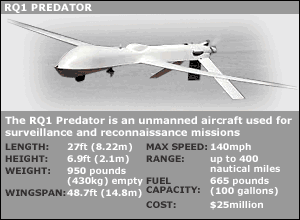| You are in: In Depth | |||||||||||||||||||||||||||||||||||||||||||||||||||||||||||||||||||||||||||||||||||||||||||||||||||||||||||||||||||||||||||||||||||||||||||||||||||||||||||||||||||||||||||||||||||||||||||||||
|
Tuesday, 5
November, 2002, 13:04 GMT
US drones take combat role

The six were killed when their car was hit by a missile fired by a CIA unmanned aerial vehicle (UAV) or drone, according to unnamed sources.
The BBC's Defence Correspondent, Jonathan Marcus, says that the CIA has been using Predator drones armed with anti-tank missiles in Afghanistan. It is likely that this was the sort of drone used in the Yemen attack. It could have been launched by US forces in Djibouti, across the Red Sea from Yemen.
On 25 October, the US Defense Department admitted for the first time that it was using armed drones to attack targets which threatened US and British air patrols over southern Iraq. In the past, drones have been used as a cheap form of aerial reconnaissance which avoided endangering pilots' lives The chairman of the US Joint Chiefs of Staff, General Richard Myers, said the advantage of using Predator drones in combat was that they could remain in the air for long periods and then respond immediately if they spot hostile targets. New role in Afghanistan The use of unmanned aircraft carrying cameras or sensors to gather intelligence started in the 1950s and has developed steadily since then. Initially, they had a limited range, could only stay in the air for short periods and were prone to communications and control problems. Today, according to Jonathan Marcus, the American Global Hawk UAV can loiter over the battlefield for up to 24 hours at altitudes greater than 60,000 feet (18.3 km), providing real-time intelligence to commanders who may be far away from the scene of the engagement.
But the war against al-Qaeda and the Taleban led to drones being specially adapted to carry weapons - notably Hellfire anti-armour missiles. Reports from Afghanistan said that drones had been able to locate key al-Qaeda or Taleban leaders, but ground or air attack units had then been unable to follow up with successful combat missions. Henceforth the capability to attack targets was identified as a valuable addition to the drone's usefulness. The adapted drones were used in Afghanistan and now in Iraq and, it is presumed, in the attack against al-Qaeda suspects in Yemen. Widely used intelligence tool The United States is far from being the only country to use drones. Israel is a major producer and user of military drones, using them for reconnaissance of its borders and to gather military intelligence about its Arab neighbours' military capabilities. In June, Pakistan shot down a drone being used by the Indian military along their border. It is believed that Israel had sold India Hunter and Searcher drones in the late 1990s. Those UAVs are like very large model aircraft and carry cameras and sensors rather than weapons. Two years ago, the Iraqi news agency reported that the country's air defences had shot down an Iranian drone which had intruded into its air space. Key weapon against Iraq The US used drones in the Balkans in 1999 and lost at least one of them due either to hostile fire or control problems resulting from a build up of ice on their wings.
Afghanistan was the first conflict in which drones are known to have been used as weapons platforms. Now they are being used against al-Qaeda and their use is likely to expand in the future because of their flexibility and because they do not directly put US personnel at risk in attacks on targets. It is thought that after the extensive bombing campaign there, the US has been building up its stockpile of UAVs ahead of any conflict with Iraq, where the drones could play a major role as part of the US arsenal of so-called smart weapons. |
See also:
06 Dec 00 | Middle
East
13 Oct 00 | Middle
East
02 Nov 02 | Country
profiles
30 Oct 02 | Middle
East
17 Oct
02 | Business
14 Mar 02 | Middle
East
08 Jun 02 | South
Asia
Internet links:
The BBC is not responsible for the content of external internet sites | |||||||||||||||||||||||||||||||||||||||||||||||||||||||||||||||||||||||||||||||||||||||||||||||||||||||||||||||||||||||||||||||||||||||||||||||||||||||||||||||||||||||||||||||||||||||||||||
| ----------------------------------------------------------------------------------
To BBC Sport>> | To BBC Weather>> | To BBC World Service>> ---------------------------------------------------------------------------------- © MMIII | News Sources | Privacy |